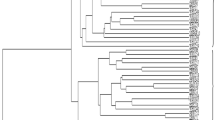Summary
The cross of two indica types of rice T9 and M35, provided scope for the inheritance study of 16 characters such as flowering, awning and awn colour, panicle density and panicle exsertion, presence of ligule, bent node, and pigmentation in ten other characters. Besides the purple colour, yellow and chalky white were studied for their inheritance. Two to five pairs of factors were found to govern the 16 characters under study. Complementary, duplicate, complementary duplicate, inhibitory complementary and inhibitory duplicate action of genes was observed. Independent dominant action of individual genes which is equivalent to the action of two or three genes is recorded in respect of panicle density and awning and awn colour. Inheritance of the 16 characters shows the involvement of 59 genes unreported in the past. Out of them 19 are inhibitors. Combined segregation data have revaled the existence of many pleiotropic genes acting on two or more characters and exhibiting differential expression in some of them, which is an interesting part of the present study. Linkage analysis has resulted in the assignment of the record number of 17 genes to a single group, nine of them being inhibitors. The linkage map constructed in the order of genes as suggested by the cross over values shows a good agreement. This linkage group is concluded not to form part of any group propounded by Misro et al. (1966) in indica rice.
Similar content being viewed by others
References
Anonymous, 1959. Genetic symbols for rice recommended by the International Rice Commission. Int. Rice Comm. Newsl. 8 (4): 1–7.
Bhattacharya, R. K., 1957. Genetics of rice (Oryzasativa L.) Inheritance of anthocyanin pigmentation and other morphological characters in intervarietal crosses within indica group. Assoc. I.A.R.I. Thesis, 1957.
Chakravorty, A. K., 1948. A genetical study of botanical characters in rice Oryza sativa L. Bull. Bot. Soc. Bengal 2: 50–58.
Dhulappanavar, C. V. 1973a. Differential expression of pleiotropic genes for pigmentation in rice (Oryza sativa L.). Curr. Sci. 42: 252–253.
Dhulappanavar, C. V., 1973b. A pleiotropic inhibitory gene in rice. Indian J. agric. Sci. 43: 848–851.
Dhulappanavar, C. V., 1975. Differential expression of a pleiotropic gene for flowering in rice. IL-RISO 24: 287–292.
Dhulappanavar, C. V., A. K. Kolhe & R. D'Cruz, 1973. Inheritance of pigmentation in rice III. Auricle, junctura, pulvinus and leaf axil. Ind. J. Genet. 33: 389–392.
Fisher, R. A. & Balmakund, 1928. The estimation of linkage from the offspring of selfed heterozygotes. J. Genet. 20: 79–92.
Ghose, R. L. M., W. T. Butany & R. Seetharaman, 1957. Inheritance of ligule, auricle and junctura in rice (Oryza sativa L.). Ind. J. Genet. 17: 96–101.
Ghose, R. L. M., M. B. Gharge & V. Subrahmanyan, 1960. Rice in India. ICAR, India Sci. Monogr. 1–474.
Haldane, J. B. S., 1953. A class of efficient estimates of a parameter. Proc. Int. Stat. Conf., India 1953.
Jodon, N. E., 1957. Inheritance of some of the more striking characters in rice. J. Hered. 48: 181–192.
Kosambi, D. D., 1944. The estimation of map distances from recombination values. Ann. Eugen. 12: 172–175.
Misro, B., R. H. Richaria & R. Thakur, 1966. Linkage studies in rice. Identification of linkage groups in indica rice. Oryza 3: 69–105.
Parnell, F. R., G. N. Rangaswamy Ayyangar & K. Ramiah, 1917. The inheritance of characters in rice, I. Mem. Dept. Agri. India, Bot. Ser. 9: 75–105.
Patil, V. P. & V. M. Raut, 1970. Calculation of linkage values by product ratio method (cases involving quadrigenic complementary interaction). Res. J. Mahatma Phule Agri. Univ. 1: 29–36.
Pawar, M. S., P. Narahari & V. V. S. Murthy, 1957. Studies on the absence of junctura, auricle and ligule in rice (Oryza sativa L.). Ann. Bot. (Lond.) 21: 381–384.
Richharia, R. H., B. Misro, W. T. Butany & R. Seetharaman, 1960. Linkage studies in rice (Oryza sativa L.). Euphytica: 9(1): 122–126.
Richharia, R. H. & B. Misro, 1962a. Evolutionary tendencies in rice based on genetic evidence. Bull. nat. Inst. Sci. India, No. 19: 20–30.
Richharia, R. H., B. Misro & R. Seetharaman, 1962b. Linkage studies in rice, Oryza sativa L. II second Rice Research Workers Conference Srinagar, Breeding and genetics item-2.
Author information
Authors and Affiliations
Rights and permissions
About this article
Cite this article
Dhulappanavar, C.V. Linkage studies in rice (Oryza sativa L.): Flowering, awning and awn colour, panicle density and exsertion, liguleless, bent node and pigmentation. Euphytica 30, 771–790 (1981). https://doi.org/10.1007/BF00038807
Received:
Issue Date:
DOI: https://doi.org/10.1007/BF00038807




